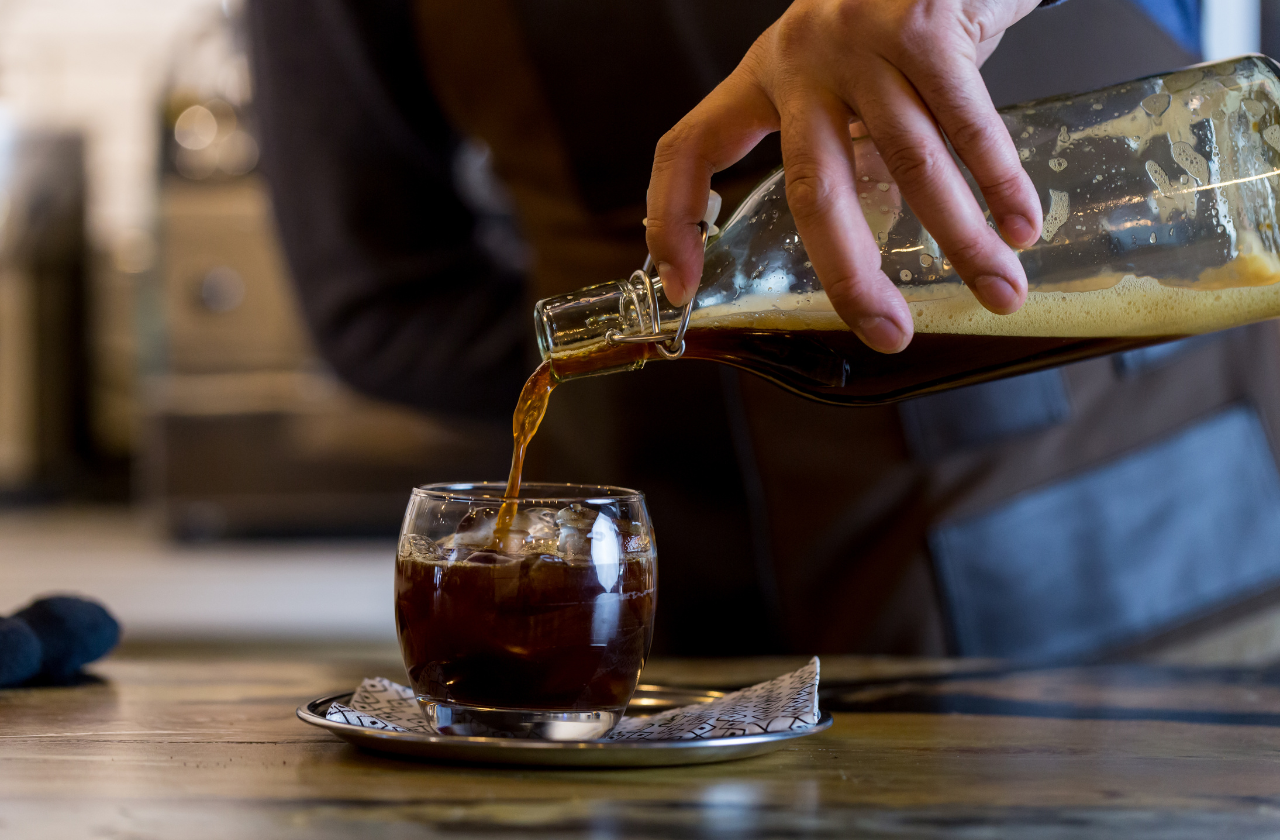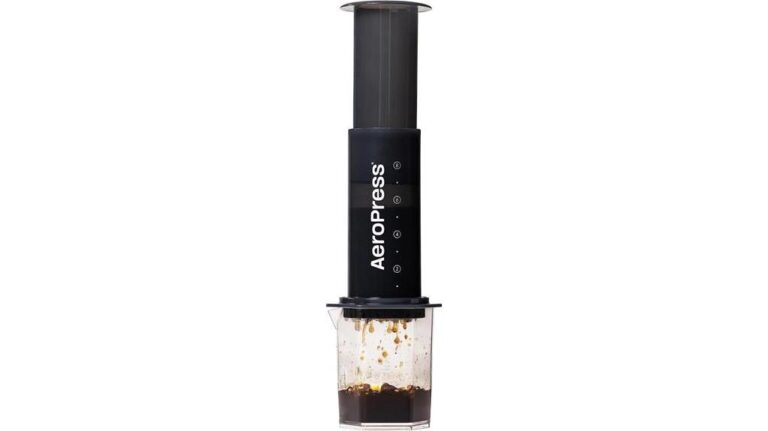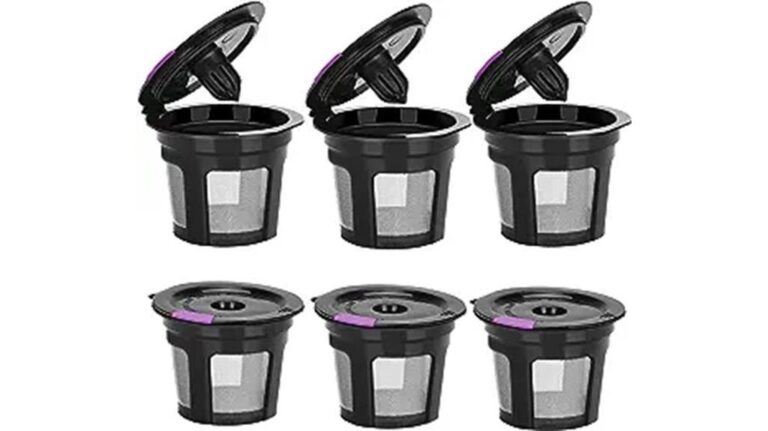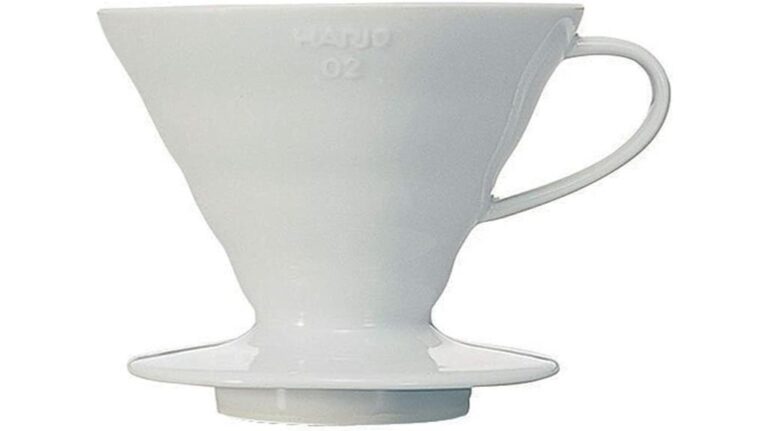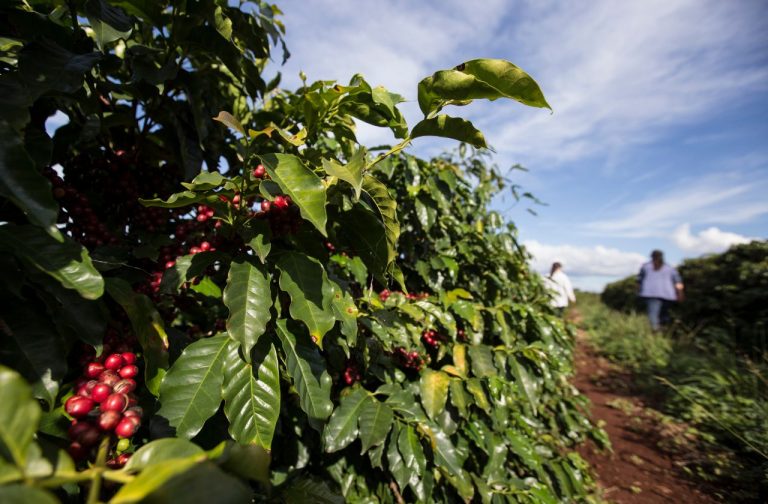9 Best Cold Brew Techniques for Superior Flavor
Cold brew has gained popularity due to its ability to extract a smooth and strong flavor profile from almost any coffee beans and its ability to extract flavor without the bitterness and acidity that can be found in traditional hot brewed coffee. There are several cold brew methods that anyone can use:
- Traditional Cold Brew
- Japanese Iced Coffee
- Immersion Cold Brew
- Slow Drip Cold Brew
- French Press Cold Brew
- Mason Jar Cold Brew
- Toddy System Cold Brew
- AeroPress Cold Brew
- Coffee Sock Cold Brew
From the classic immersion method, where coffee grounds are steeped in water for an extended period, to the slow drip approach that involves a slow and controlled extraction process, there is a technique suited for every coffee enthusiast. By understanding the intricacies of each method and experimenting with different variables, you can unlock a whole new world of flavors in your cold brew.
Traditional Cold Brew Method

The traditional cold brew method is widely regarded as one of the most popular techniques for achieving a superior flavor in cold brew coffee. Brewing temperature and coffee grind size are two key factors that contribute to the success of this method.
Regarding brewing temperature, it is important to note that cold brew coffee is brewed using cold or room temperature water rather than hot water. This lower temperature allows for a slower extraction process, resulting in a smoother and less acidic flavor profile.
The ideal brewing temperature for cold brew coffee is between 36 to 40 degrees Fahrenheit (2 to 4 degrees Celsius), as this range promotes optimal flavor extraction without any unwanted bitterness.
In addition to brewing temperature, the coffee grind size plays a crucial role in achieving a superior flavor in traditional cold brew. For cold brew, a coarser grind size is recommended. This is because a coarser grind allows for a slower extraction process, resulting in a smoother and less bitter cup of coffee.
A medium-coarse grind size, similar to that of coarse sea salt, is typically preferred for traditional cold brew.
Japanese Iced Coffee Technique
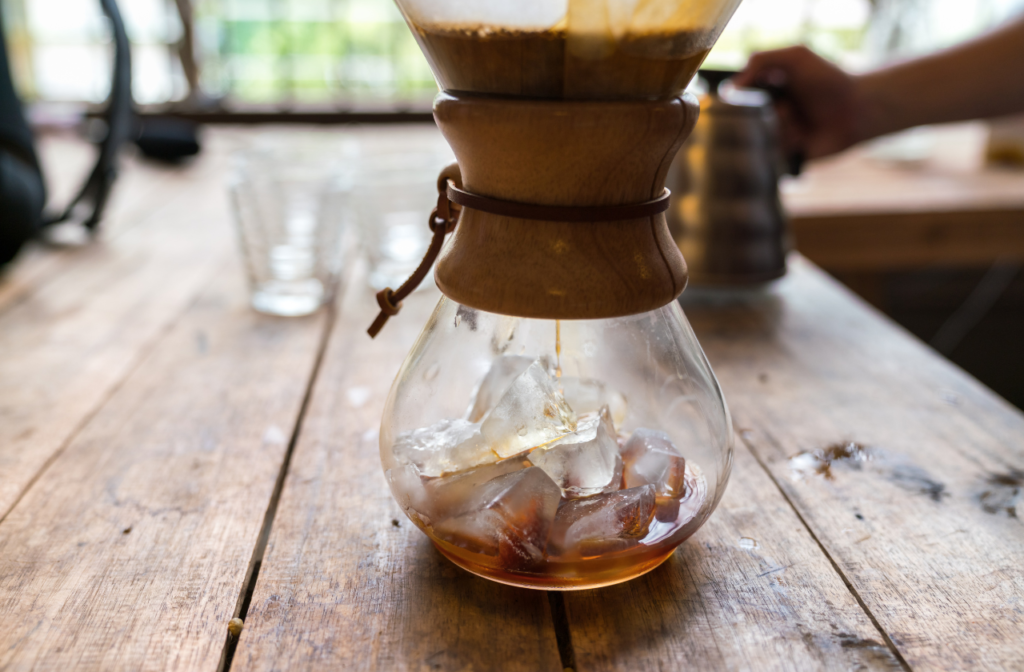
How can the Japanese iced coffee technique enhance the flavor of cold brew coffee?
The Japanese iced coffee technique is a method that involves brewing coffee using hot water directly over ice. This technique is known for its ability to create a bright and flavorful cup of cold brew coffee that preserves the delicate aromas and nuances of the coffee beans.
One key aspect of the Japanese iced coffee technique is the brewing temperature. Unlike traditional cold brew methods that use room temperature or cold water, the Japanese method uses hot water to extract the flavors from the coffee grounds. The hot water allows for a quicker extraction process, resulting in a more vibrant and complex flavor profile.
Another important factor in the Japanese iced coffee technique is the coffee-to-water ratio. It is crucial to maintain the right balance between coffee and water to achieve the desired taste.
The recommended ratio is typically 1:15 or 1:16, meaning 1 part coffee to 15 or 16 parts water. This ratio ensures that the coffee is properly extracted and avoids any over- or under-extraction that can lead to bitterness or weak flavors.
Immersion Cold Brew Process

One method that builds upon the Japanese iced coffee technique preserving the nuanced flavors of the beans, is the immersion cold brew process.
Unlike the Japanese method, where hot water is poured over coffee grounds and then immediately cooled, the immersion process involves steeping coffee grounds in cold water for an extended period of time. This allows for a slower extraction process, resulting in a smoother and less acidic brew.
When using the immersion cold brew process, it is important to consider the brewing temperature. Cold water is ideal, as it helps to extract the flavors from the coffee grounds without extracting the bitter compounds that can be released at higher temperatures.
The recommended brewing temperature for immersion cold brew is between 36 and 45 degrees Fahrenheit.
The immersion method also allows for the creation of cold brew concentrate. By increasing the coffee-to-water ratio, a stronger and more concentrated cold brew can be achieved. This concentrate can then be diluted with water or milk to achieve the desired strength and flavor.
To make an immersion cold brew, start by combining coarsely ground coffee and cold water in a container. Let it steep for at least 12 hours or up to 24 hours for a more intense flavor.
Once steeped, strain the mixture to separate the grounds from the liquid. The resulting cold brew concentrate can be stored in the refrigerator for up to two weeks.
The immersion cold brew process provides a unique and flavorful way to enjoy cold coffee. By adjusting the brewing temperature and experimenting with different coffee-to-water ratios, coffee enthusiasts can achieve a cold brew that is perfectly suited to their taste preferences.
Weird Coffee Tip: Immersion cold brewing is the simplest and most controllable way to make good cold brew, making it the preferred method among coffee enthusiasts. Find out more about cold brewing here.
Slow Drip Cold Brew Method
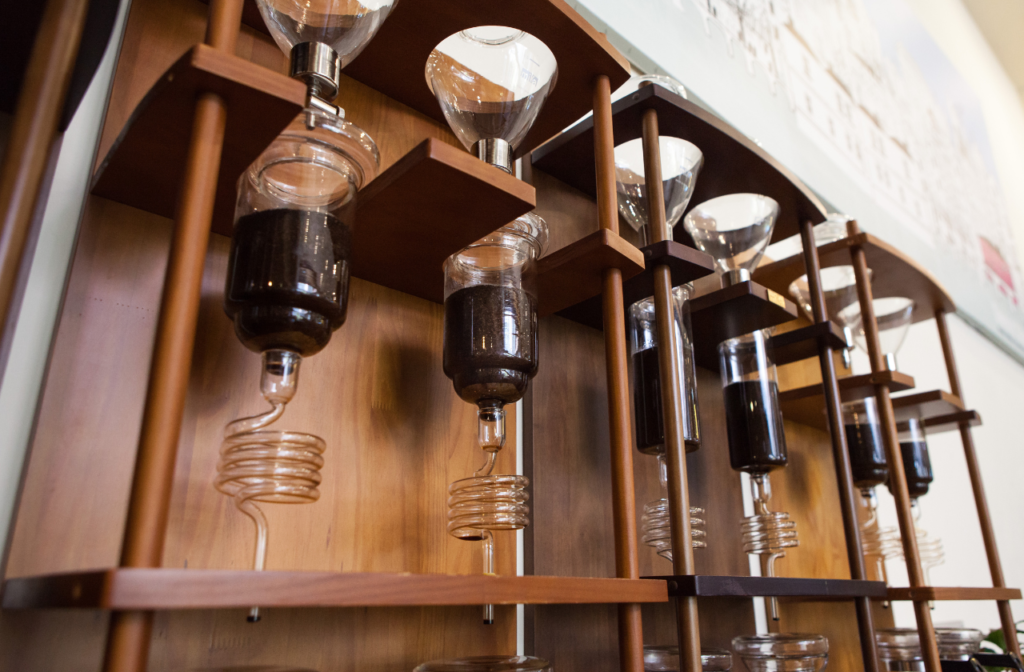
The slow-drip cold brew method is a popular technique for achieving superior flavor in cold brew coffee. This method allows for a more controlled extraction process, resulting in a smoother and less acidic brew.
The brewing time can vary depending on the desired strength, with longer brewing times typically producing a stronger flavor profile.
For beginners, it is recommended to use a slow-drip cold brew tower or a cold brew dripper to simplify the process and ensure consistent results.
Flavor Benefits Explained
With the slow-drip cold brew method, flavor benefits are maximized through a precise and controlled extraction process. This method allows for optimal flavor extraction by slowly dripping cold water over a bed of coffee grounds, resulting in a smooth and well-balanced brew.
The slow drip technique ensures that the water has ample time to interact with the coffee, allowing for a more thorough extraction of flavor compounds. Additionally, the brewing temperature is carefully controlled during the process, ensuring that the coffee is not exposed to high temperatures that can lead to bitterness or over-extraction.
This gentle extraction process brings out the subtle and nuanced flavors of the coffee, resulting in a rich and complex cold brew that is highly satisfying to the discerning palate.
Brewing Time Variations
Continuing the exploration of the slow drip cold brew technique, variations in brewing time play a crucial role in achieving superior flavor extraction. To achieve the best results, it is important to consider the brewing temperature and the grind size of the coffee beans.
First, let’s talk about brewing temperature. When using the slow drip method, it is recommended to brew the cold brew at a slightly higher temperature than traditional methods. Aim for a brewing temperature between 195°F and 205°F to extract the maximum flavors from the coffee grounds.
Next, the grind size of the coffee beans also affects the brewing time. Finer grind sizes tend to extract flavors more quickly, resulting in a shorter brewing time. On the other hand, coarser grind sizes require a longer brewing time to achieve optimal flavor extraction.
Equipment Recommendations for Beginners
To delve into the realm of equipment recommendations for beginners in the slow-drip cold brew method, we must consider the essential tools needed to achieve optimal results.
When it comes to equipment options, the most crucial piece is the slow-drip cold brew maker itself. This device allows for a controlled and consistent extraction process, ensuring a well-balanced and flavorful brew.
Additionally, a high-quality coffee grinder is essential for achieving a consistent grind size, which directly impacts the extraction process.
As for brewing ratios, beginners should start with a 1:8 coffee-to-water ratio and adjust according to personal preference. This ratio provides a good starting point for beginners to experiment and find their desired strength and flavor profile.
French Press Cold Brew Technique

The French Press technique for cold brew coffee offers a unique and flavorful brewing method. With its simple design and ease of use, the French Press is a popular choice among coffee enthusiasts.
Advantages:
- Full-bodied flavor: The French Press allows for maximum extraction of flavor from the coffee grounds, resulting in a rich and robust brew.
- Versatility: The French Press can be used for both hot and cold brews, making it a versatile tool in your coffee brewing arsenal.
- Easy cleanup: With its removable metal filter, cleaning up after brewing is a breeze.
Recipe Variations:
- Classic French Press Cold Brew: Start by combining coarsely ground coffee and cold water in the French Press. Let it steep in the refrigerator for 12-24 hours. Press down the plunger slowly and enjoy the smooth and full-bodied cold brew.
- Flavored Cold Brew: Add spices like cinnamon or vanilla extract to the coffee grounds before brewing for a unique twist on your cold brew. Experiment with different flavors to find your favorite combination.
The French Press technique offers a convenient and delicious way to enjoy cold brew coffee. Its advantages and recipe variations allow for customization and experimentation, making it a favorite among coffee connoisseurs.
Mason Jar Cold Brew Approach
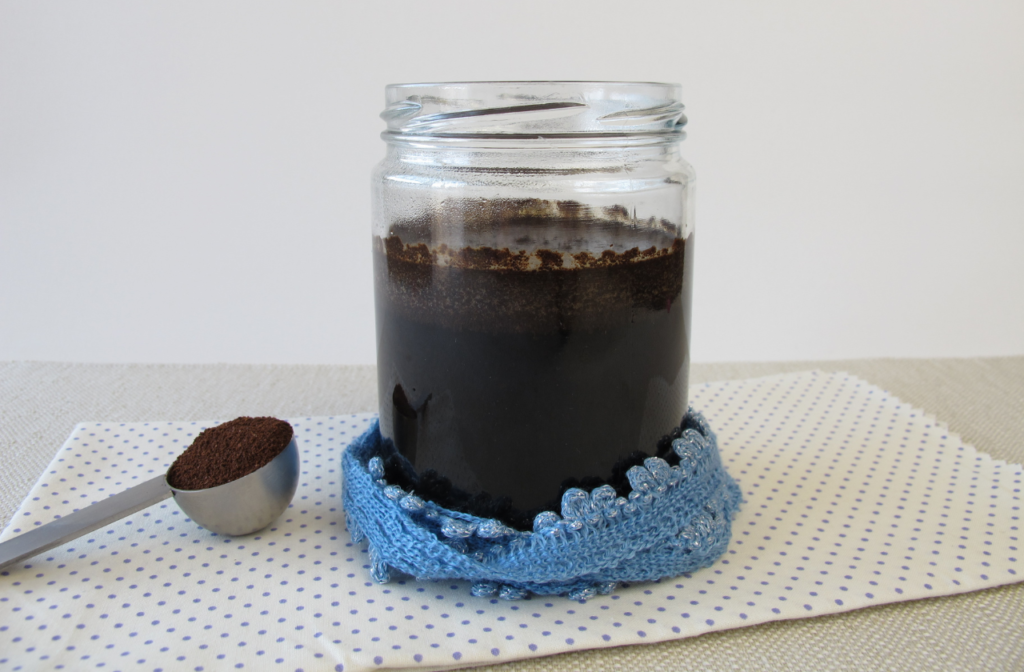
When it comes to choosing between a mason jar and a pitcher for cold brewing, there are a few factors to consider.
The size and shape of the container can affect the extraction process and the flavor of the final brew.
Additionally, brewing time recommendations may vary depending on the vessel used.
Let’s explore these points in more detail to understand how to achieve the best results with the mason jar cold brew approach.
Jar Vs. Pitcher
There are distinct advantages to using a jar rather than a pitcher when employing the Mason jar cold brew approach. Here are the pros and cons of using a mason jar versus a pitcher for cold brewing coffee:
Pros of using a mason jar:
- Superior flavor: The glass construction of a mason jar helps to maintain the purity of the coffee’s taste, resulting in a more flavorful and aromatic brew.
- Portability: Mason jars are compact and easy to carry, making them ideal for on-the-go coffee lovers.
Cons of using a pitcher:
- Dilution risk: Pitchers typically have a larger volume, which can lead to over-extraction and dilution of the coffee if not properly measured or timed.
- Limited portability: Pitchers are bulkier and less convenient to transport, making them less suitable for those who prefer to enjoy their cold brew outside of their homes.
When deciding between a mason jar and a pitcher for your cold brew, consider these factors to ensure the best brewing experience and flavor profile.
Brewing Time Recommendations
For optimal results in the Mason jar cold brew approach, it is recommended to brew the coffee for a minimum of 12 hours. However, brewing time can vary depending on personal preferences and experimentation.
The length of brewing time directly affects the flavor profile and strength of the cold brew. Longer brewing times typically result in a stronger, more robust flavor, while shorter brewing times produce a milder taste.
It is important to note that the impact of grind size should also be considered when determining the ideal brewing time. Finely ground coffee will extract more quickly, whereas coarsely ground coffee requires a longer steeping time.
Cold Brew With a Toddy System
Using the Toddy system is a popular method for achieving a smooth and rich cold brew flavor. This system, invented in 1964 by Todd Simpson, allows you to make cold brew concentrate that can be used in a variety of cold brew recipes.
Here are some reasons why the Toddy system is a favorite among cold brew enthusiasts:
- Consistent Extraction: The Toddy system utilizes a unique cold brew method that extracts the coffee’s flavors slowly and evenly. This results in a concentrate that is rich, smooth, and less acidic than traditional hot brewed coffee.
- Easy to Use: The Toddy system is designed with simplicity in mind. All you need to do is add coarsely ground coffee to the filter, pour cold water over it, and let it steep for 12 to 24 hours. The system’s reusable filters make cleanup a breeze.
- Versatility: With the cold brew concentrate produced by the Toddy system, you have the freedom to create a wide range of cold brew recipes. From iced coffee to espresso-based drinks, the possibilities are endless.
- Cost-effective: Making cold brew with the Toddy system allows you to save money compared to buying pre-made cold brew drinks. You can make large batches of concentrate at once and store it in the refrigerator for up to two weeks.
Cold Brew Using an Aeropress

The Aeropress is a versatile tool for creating delicious cold brew coffee. While it is primarily known for its ability to make hot coffee quickly, it can also be used to achieve a smooth and flavorful cup of cold brew. This method is perfect for those who prefer a smaller batch and want to experiment with alternative brewing methods.
To make cold brew using an Aeropress, start by grinding your coffee beans to a medium-coarse consistency. Place the ground coffee into the Aeropress chamber, and add cold water in a ratio of 1:4 coffee to water. Stir gently to ensure all the grounds are saturated, and let it steep for 12-24 hours in the refrigerator.
Once the steeping time is over, attach the filter cap and flip the Aeropress onto a cup or carafe. Press down slowly and steadily, extracting the concentrated cold brew into your container. Dilute the concentrate with water or milk to your desired strength and taste.
The Aeropress cold brew method yields a clean and vibrant cup of coffee with subtle flavors and low acidity. It’s a great option for those who appreciate the nuances of coffee and want to explore alternative brewing techniques.
Cold Brew With a Coffeesock
To achieve a superior flavor in your cold brew, consider utilizing a Coffeesock for a more refined and nuanced coffee experience. The Coffeesock is a reusable, organic cotton filter that allows you to extract the full flavor potential of your coffee grounds while eliminating the need for paper filters or plastic pods.
Here are some benefits of using a Coffeesock for your cold brew:
- Enhanced Flavor: The Coffeesock allows for a slower extraction process, resulting in a smoother and less acidic cold brew. This method brings out the natural sweetness of the coffee beans, creating a more balanced and enjoyable flavor profile.
- Environmental Consciousness: By opting for a Coffeesock, you are reducing waste by eliminating the need for disposable filters. This eco-friendly alternative is not only better for the planet but also for your wallet in the long run.
When it comes to alternative brewing methods, the use of a Coffeesock stands out for its ability to produce a superior cold brew. Its benefits lie in the enhanced flavor and the reduction of environmental footprint. By investing in a Coffeesock, you can elevate your cold brew experience and enjoy a more sustainable approach to coffee brewing.
Conclusion
In conclusion, there are various techniques for making cold brew coffee that can result in superior flavor.
From the traditional method to Japanese iced coffee, immersion cold brew, slow drip, French press, mason jar, Toddy system, Aeropress, and Coffeesock, each approach offers a unique taste profile.
By following these techniques and experimenting with different ratios and brewing times, coffee enthusiasts can find the perfect cold brew method that suits their preferences and creates a delicious and refreshing beverage.
